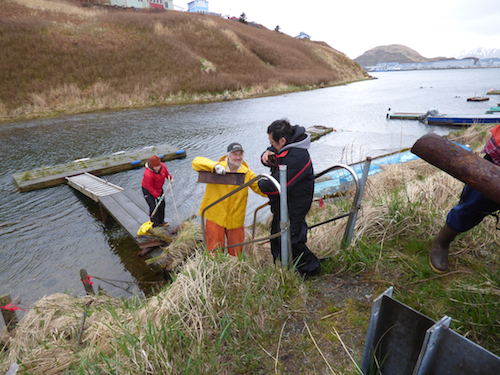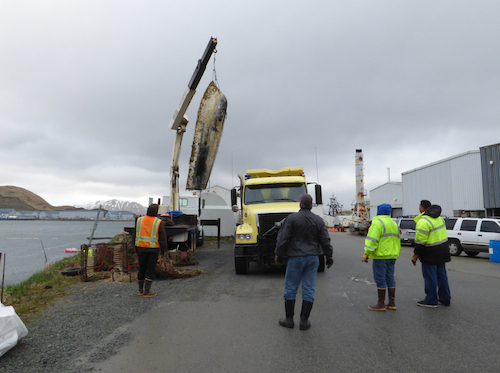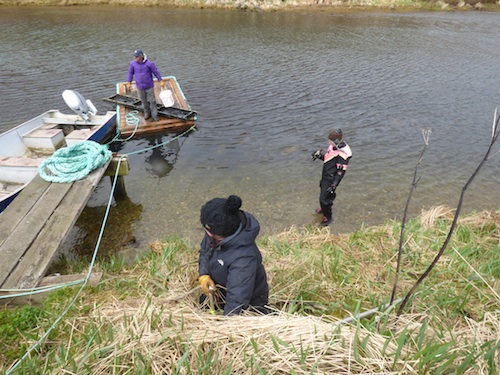Clean-Up Pulls Old Skiffs, Docks and More from Iliuliuk River

Monday, May 11 2015

Walter Tellman, in yellow, watches with Frank Kelty as a city boom truck tries to lift an old skiff out of the river during Saturday's clean-up. (Annie Ropeik/KUCB)
The creek that runs through the heart of Unalaska can support thousands of salmon every year. It’s also full of decades worth of junk. With salmon runs declining, locals have been leading the charge to clean up the watershed. KUCB’s Annie Ropeik was there on Saturday as they got started.
(metal clunking)
Walter Tellman: We’ve got one more heavy pipe here…
Walter Tellman and Laresa Syverson are up to their ankles in Unalaska’s Iliuliuk River, handing pipe after rusted pipe up the banks.
Syverson: The first one was exposed, and then there were four more underneath. (laughs)
Ropeik: How does this stuff get in there? What was it ever doing?
Tellman: Vince [Tutiakoff] was saying [it was] a mail-boat float that kind of got overgrown -- it goes back a little ways.

Walter Tellman, in yellow, passes up a metal beam from an old dock during Saturday's clean-up. (Annie Ropeik/KUCB)
These mystery pipes are just a little bit of the five tons of junk being pulled out of the water today: everything from ropes and crab pots, to World War II debris, to even bigger things.
Vince Tutiakoff: They got a boat down there in the water they’re trying to get ahold of that’s underwater. Oh, maybe he’s pulling it up now.
Vince Tutiakoff is watching as a city boom truck pulls a whole skiff out of the creek. He’s president of the Unalaska Native Fishermen’s Association, and the elder advisor to the Qawalangin Tribe. The groups are funding this clean-up with $30,000 over the next three years.
(cheers)
Tutiakoff: That’s a good skiff! Nothing wrong with that boat.
In fact, it’s barely in one piece -- covered in muck and kelp from years underwater. The crew ties a rope around it, but it’s too slimy to lift. So Tutiakoff tries something else.
(hammering)
He uses a found crowbar to punch holes in the fiberglass, then slides the rope through.
(truck honk; clunking)
And up goes the boat, into a dump truck and off to the landfill.

Workers watch as a boom truck lifts an old skiff off the riverbank and into a waiting dump truck. (Annie Ropeik/KUCB)
Further up the creek, Melissa Good is wading around among more active docks and skiffs, picking up plywood, sheet metal, and some interesting treasures.
“I have a wine bottle with a busted top,” she says, clinking the glass against a dock. “Someone used it to christen their boat, and it went back to the bottom. So now it’s out.”

Melissa Good, right, inspects a barnacle-encrusted wine bottle found in the creek as others pull rope out of the riverbank and clean up floats. (Annie Ropeik/KUCB)
Good is Unalaska’s Marine Advisory Program agent, a University of Alaska employee who’s basically the town scientist. She explains why all this is good for the salmon:
“When you’ve got all these boards and all the sunken floats laying on the bottom, you’re covering up the salmon habitat. They need that rocky bottom,” she says. “The humpies are spawning actually in the creek bed, and so you want that habitat available for them.”
Humpies aren’t the only salmon that run through the creek. Others spawn where it ends, in Unalaska Lake. The city got a grant to work on that area, from the region’s now-defunct Coastal Zone Management program. Assistant city manager Patrick Jordan says that money focuses on preventing gravel runoff from nearby roads.
“That is gonna include sediment traps, those kinds of things -- construction related items,” he says. “But until that comes through we can’t do anything on the upper end, so this is nice that the community came out, and UNFA and the tribe put this together to make a dent in this down here, and we’re putting a pretty good dent in it.”
The city also got a grant for the river -- but the requirements for using it didn’t line up with what locals said they wanted to see. Now, Unalaska is waiting on state and federal approvals to use the river money at the lake.
That means it won’t be available for last thing locals had wanted: a fish weir to count salmon and replace anecdotal evidence of shrinking runs with hard data.
The city and local groups might try to build one themselves down the line. But for now, Vince Tutiakoff says they’ll tackle the issue with what’s in front of them: a river full of trash.
“That may not be the problem, but we’ll find out,” he says. “A lot of stuff is going in the creek here, from the debris -- people are going up and down the creek and dumping their bottles and cans and everything else … and the line and the mesh web from the crab pots -- you get down in there and the salmon get caught up in it. So we try to clean it out.”
The creek is just one part of a habitat that sees pollution from a lot of different sources. But after this weekend, it’s cleaner than it’s been in generations. Going forward, Tutiakoff says they’ll work with people who still use the creek to try and keep it that way.


